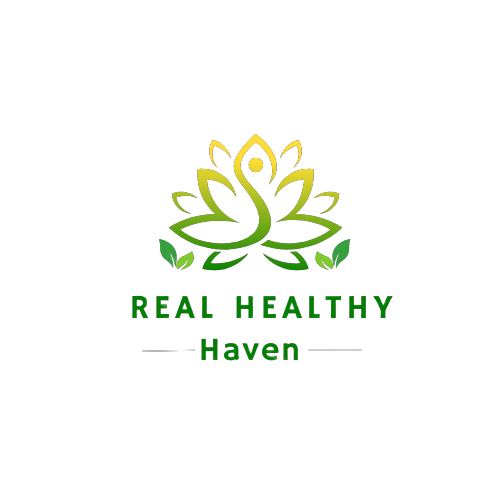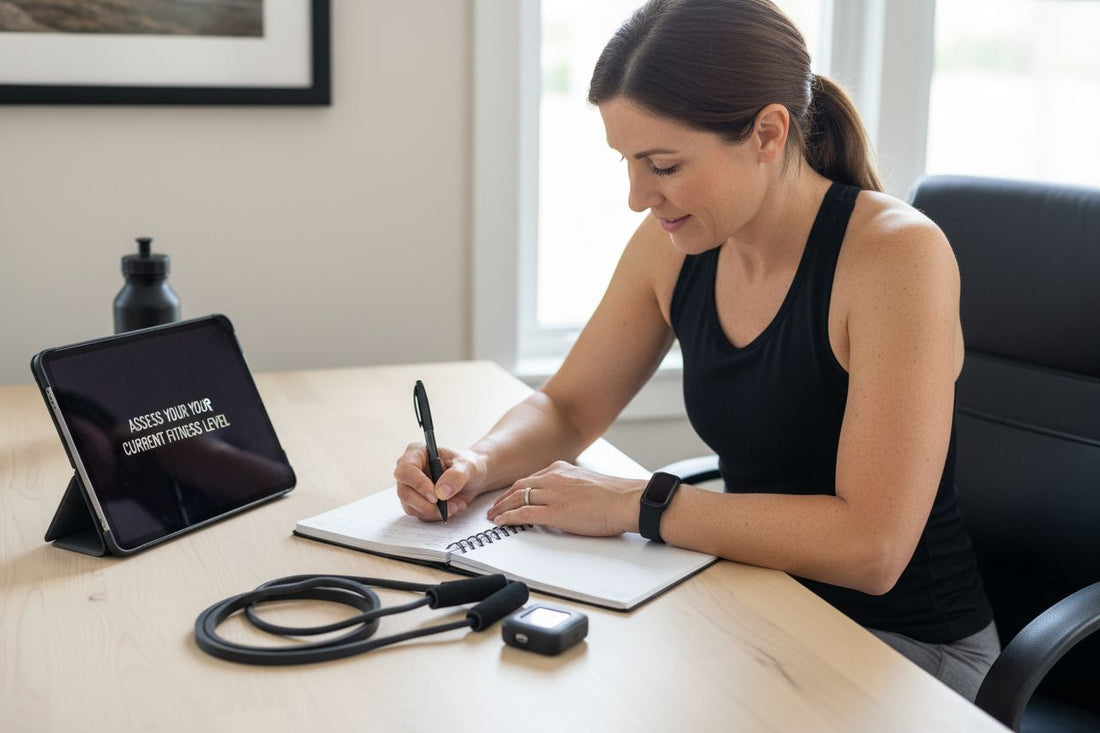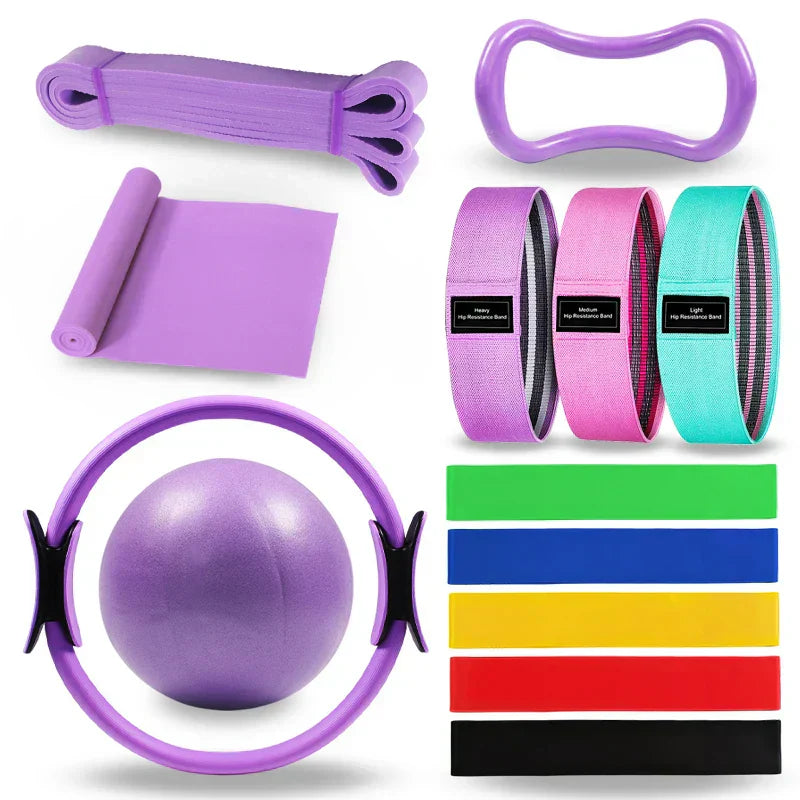Getting fit after 40 can feel impossible. Over half of adults skip regular exercise, and many admit they have no idea where to start when it comes to setting realistic goals. Yet surprisingly, detailed self-assessment—not gym memberships or strict diets—turns out to be the most powerful first step. Those who take the time to measure their current fitness see up to 70 percent improvement in reaching their goals compared to those who guess. Most people ignore this easy strategy and make things harder on themselves.
Table of Contents
- Step 1: Assess Your Current Fitness Level
- Step 2: Define Specific and Measurable Goals
- Step 3: Create a Realistic Action Plan
- Step 4: Incorporate Suitable Activities and Exercises
- Step 5: Monitor Progress and Adjust Goals as Needed
Quick Summary
| Key Point | Explanation |
|---|---|
| 1. Assess Your Current Fitness Level | Conduct a thorough evaluation of your physical condition, including endurance, strength, and flexibility. |
| 2. Set Specific and Measurable Goals | Use the SMART criteria to establish clear, achievable fitness objectives tailored to your needs. |
| 3. Create a Realistic Action Plan | Develop a sustainable routine considering your schedule, energy levels, and resources, focusing on consistency. |
| 4. Incorporate Suitable Activities | Choose enjoyable exercises that enhance cardiovascular fitness, strength, flexibility, and balance tailored for your age. |
| 5. Monitor Progress Regularly | Track your progress comprehensively and adjust goals as necessary, celebrating achievements and understanding your body’s responses. |
Step 1: Assess Your Current Fitness Level
Creating effective fitness goals for individuals over 40 starts with a comprehensive and honest assessment of your current physical condition. This initial evaluation provides a critical baseline from which you can develop personalized, achievable fitness objectives that align with your body’s unique capabilities and limitations.
Understanding Your Starting Point
Before diving into any fitness program, you need a clear picture of your current health and fitness status. Physical self-assessment goes beyond simply stepping on a scale or checking your weight. It involves a holistic examination of your cardiovascular endurance, muscular strength, flexibility, and overall mobility.
According to research from the National Institutes of Health, a structured fitness assessment for adults over 40 should include several key components. Begin by scheduling a comprehensive physical examination with your healthcare provider. This medical consultation will help identify any underlying health conditions, assess potential risks, and provide professional guidance tailored to your specific needs.
During your medical evaluation, request specific tests that provide insights into your fitness baseline. These might include:
- Resting heart rate measurement
- Blood pressure screening
- Cardiovascular endurance test
- Muscular strength and flexibility assessment
- Balance and mobility evaluation
Additionally, consider performing some at-home fitness tests that can give you immediate insights. A simple walking test can help determine your cardiovascular fitness. Time yourself walking a set distance (like one mile) and note how you feel during and after the exercise. Pay attention to your breathing, muscle fatigue, and overall comfort level.
For strength assessment, try basic exercises like modified push-ups, wall squats, or holding a plank position. The duration and ease with which you complete these exercises can reveal your current muscle strength and endurance. Remember, the goal is not to compete or compare yourself to younger individuals but to establish a personal benchmark.
Flexibility is another crucial aspect of fitness for adults over 40. Perform simple stretching exercises and note any limitations or discomfort.
Below is a table summarizing various fitness assessment components for adults over 40, including what each component evaluates and example methods mentioned in the article.
| Assessment Component | What It Evaluates | Example Method or Test |
|---|---|---|
| Cardiovascular Endurance | Heart and lung function | One-mile walk test, resting heart rate |
| Muscular Strength | Muscle capacity | Modified push-ups, wall squats, plank hold |
| Flexibility | Range of motion | Toe touch, basic stretching exercises |
| Balance and Mobility | Stability and movement | Balance pose, mobility evaluation |
| Health Screening | Medical risks and baseline health | Physical exam, blood pressure screening |
Documenting your initial assessment is crucial. Create a fitness journal or digital record that tracks your baseline measurements, medical insights, and personal observations. This documentation will serve as a motivational tool and help you track progress as you develop and implement your fitness goals.
Step 2: Define Specific and Measurable Goals
Transforming your fitness assessment into actionable goals requires precision, strategy, and a realistic approach tailored specifically for adults over 40. This step is about translating your baseline evaluation into clear, achievable fitness objectives that motivate and challenge you without overwhelming your body.
Goal setting is not about perfection but progression. After understanding your current fitness level, you need to craft goals that are specific, measurable, attainable, relevant, and time-bound (SMART). This framework ensures your fitness journey remains structured and motivating.
According to research from the American College of Sports Medicine, creating effective fitness goals involves more than wishful thinking. Start by identifying 2-3 primary fitness objectives that align with your overall health assessment. These might include improving cardiovascular endurance, increasing muscle strength, enhancing flexibility, or managing weight.
Cardiovascular Goals: If your initial assessment revealed limited endurance, consider a goal like “Walk continuously for 30 minutes without stopping” or “Complete a 5K walk/run within six months”. Break this down into incremental milestones, such as increasing your walking distance by 10% every two weeks.
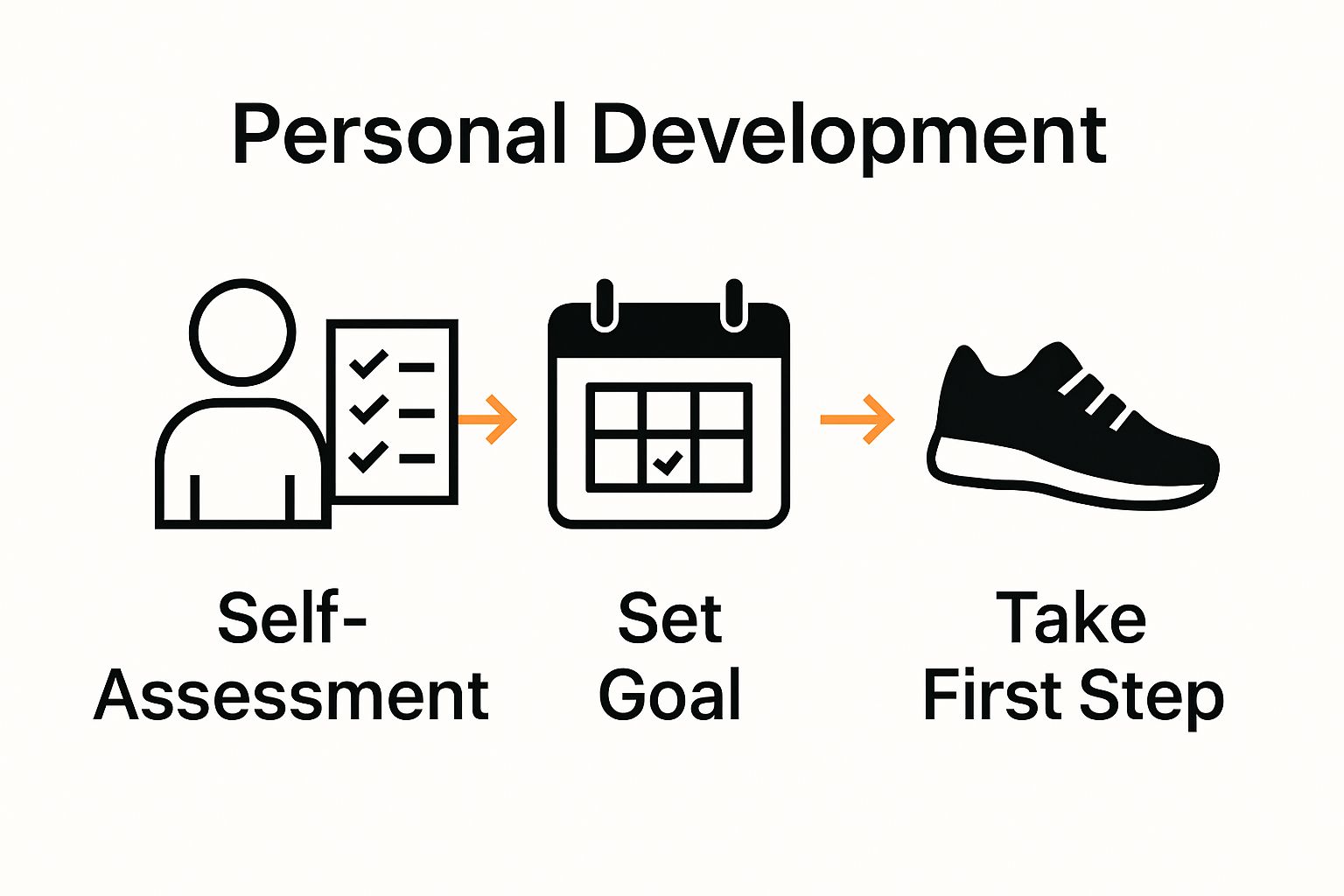
Strength Training Objectives: For muscle development and maintenance, set precise targets. An example might be “Perform 10 full push-ups with proper form” or “Increase weightlifting capacity by 20% within four months”. Remember that for adults over 40, strength training is crucial for maintaining muscle mass and bone density.
Flexibility and mobility goals are equally important. You might aim to “Touch toes without knee bend” or “Hold a balance pose for 30 seconds” by a specific date. These goals directly combat age-related stiffness and reduce injury risks.
Documenting your goals is critical. Use a fitness tracking app or a dedicated journal to record your objectives. Visualization transforms abstract goals into tangible targets. Include specific metrics like duration, repetitions, or distance alongside target completion dates.
Potential challenges are normal. Your goals might need adjustment based on progress, health changes, or unexpected limitations. Build flexibility into your plan, allowing for modifications without feeling discouraged. Regular reassessment every 4-6 weeks helps maintain momentum and ensures your goals remain challenging yet achievable.
Verification of goal setting involves creating a clear, written document outlining:
- Specific fitness objectives
- Baseline measurements
- Target completion dates
- Incremental milestones
- Potential modification strategies
By the end of this step, you should have a clear roadmap that transforms your initial fitness assessment into a structured, personalized fitness journey.
Step 3: Create a Realistic Action Plan
Transitioning from goal setting to practical implementation requires a thoughtful, strategic approach that respects your body’s capabilities and limitations. An action plan transforms your fitness aspirations from abstract concepts into structured, achievable steps that integrate seamlessly into your daily life.
Creating an effective action plan is about building sustainable momentum, not overnight transformation. Your plan should feel like a supportive roadmap, not a restrictive set of demands. Consider your personal schedule, energy levels, existing commitments, and physical capabilities when designing your fitness strategy.
According to Canadian Public Health guidelines, progressive and gradual activity development is crucial for adults over 40. Start by breaking down your broader fitness goals into weekly and daily actionable tasks. If your objective is to improve cardiovascular endurance, your initial plan might involve short, manageable walking sessions that gradually increase in duration and intensity.
Time management is critical in fitness planning. Identify specific time slots in your daily routine where exercise can naturally fit. This might mean early morning walks, lunchtime stretching, or evening strength training sessions. The key is consistency, not perfection. Choose times when you’re most likely to follow through and feel energized.
Equipment and resources play a significant role in executing your plan. Invest in comfortable, supportive workout clothing and shoes designed for your specific activities. Consider tools like resistance bands, light dumbbells, or stability balls that offer versatile, low-impact exercise options suitable for mature fitness enthusiasts.
Progression tracking becomes your motivational backbone. Use a fitness journal or smartphone app to log your activities, noting duration, intensity, and how you feel after each session. Visual progress documentation helps maintain motivation and allows for real-time plan adjustments. Your action plan should include built-in flexibility, recognizing that some days will be more challenging than others.
Addressing potential obstacles is crucial. Anticipate barriers like time constraints, energy fluctuations, or minor health issues. Design backup strategies such as shorter alternative workouts, gentle stretching routines, or rest days that keep you connected to your fitness journey without causing discouragement.
Your completed action plan should include:
- Specific weekly exercise schedule
- Detailed daily activity breakdown
- Backup workout alternatives
- Progress tracking method
- Scheduled review and adjustment periods
Remember, a realistic action plan feels empowering, not punishing. It should inspire you to move more, feel stronger, and celebrate incremental improvements in your overall health and fitness.
Step 4: Incorporate Suitable Activities and Exercises
Selecting appropriate exercises for adults over 40 requires a nuanced approach that balances challenge with safety, targeting overall fitness while respecting individual physical limitations. This step transforms your action plan into a practical, engaging fitness routine that supports your health goals without risking unnecessary strain.
Exercise selection is about finding joy and sustainability, not punishment. Your chosen activities should feel engaging, not overwhelming. Consider a holistic approach that combines cardiovascular conditioning, strength training, flexibility work, and balance exercises to create a comprehensive fitness strategy.
According to research from the American College of Sports Medicine, multi-dimensional fitness programming becomes increasingly important as we age. Low-impact cardiovascular activities like swimming, cycling, brisk walking, and elliptical training offer excellent options for maintaining heart health while minimizing joint stress.
Strength training takes on a different character for adults over 40. Focus on functional movements that support daily living rather than pursuing extreme muscle development. Bodyweight exercises, resistance band workouts, and light dumbbell training can help maintain muscle mass, improve metabolism, and support bone density. Start with 2-3 sessions per week, targeting major muscle groups with controlled, deliberate movements.
Flexibility and balance become paramount in maintaining mobility and preventing injuries. Incorporate practices like yoga, Pilates, or dedicated stretching routines that improve range of motion and core stability. These activities not only enhance physical capability but also provide mental relaxation and stress reduction.
Interest and enjoyment are crucial for long-term fitness commitment. Experiment with various activities to discover what genuinely excites you. Group fitness classes designed for mature adults, dance-based workouts, hiking, or recreational sports can provide both physical challenge and social engagement.
Consider these exercise categories for a well-rounded fitness approach:
- Low-impact cardiovascular activities
- Functional strength training
- Flexibility and mobility work
- Balance and core stabilization exercises
- Mind-body practices like yoga or tai chi
Listen to your body and progress gradually. Some days will feel more energetic than others, and that’s perfectly normal. Modify exercises as needed, using alternative movements or reducing intensity when necessary. The goal is consistent, sustainable movement that supports your overall health and wellness.
Verification of this step involves creating a diversified weekly exercise schedule that includes activities from different fitness domains, ensures adequate rest between workouts, and feels both challenging and enjoyable. Your selected exercises should align with the goals established in previous steps, providing a clear path toward improved fitness and vitality.
This table outlines the main exercise categories suitable for adults over 40, their primary benefits, and examples directly referenced in the article.
| Exercise Category | Primary Benefit | Examples from Article |
|---|---|---|
| Low-impact Cardio | Heart health, endurance | Walking, swimming, cycling, elliptical |
| Strength Training | Muscle mass, metabolism, bone density | Bodyweight, resistance bands, dumbbells |
| Flexibility & Mobility | Range of motion, injury prevention | Yoga, Pilates, stretching routines |
| Balance/Core Stabilization | Fall prevention, core strength | Balance poses, core exercises |
| Mind-Body Practices | Flexibility, relaxation, stress relief | Yoga, Tai Chi |
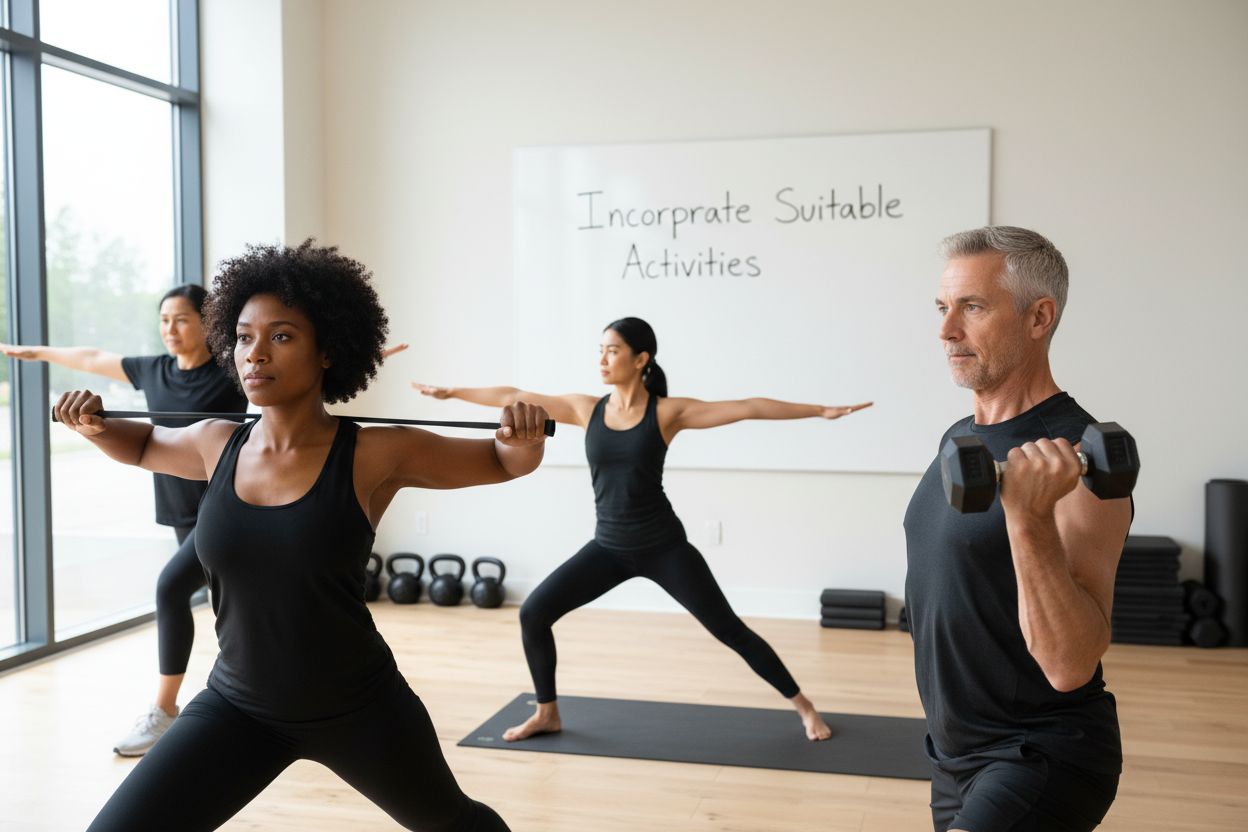
Step 5: Monitor Progress and Adjust Goals as Needed
Progress monitoring transforms your fitness journey from a static plan into a dynamic, responsive roadmap that adapts to your body’s changing needs and capabilities. This critical step ensures that your fitness goals remain challenging, achievable, and aligned with your overall health objectives.
Tracking progress is not about perfection, but about understanding your body’s unique response to exercise. Regular assessment provides valuable insights into your fitness development, helping you celebrate achievements and make informed adjustments to your approach.
According to research on self-monitoring in fitness, consistent progress tracking significantly increases the likelihood of meeting health and fitness goals. Implement a comprehensive monitoring system that goes beyond simple weight measurements, capturing multiple indicators of fitness improvement.
Utilize a combination of quantitative and qualitative tracking methods. Quantitative measurements might include tracking workout duration, repetitions, weight lifted, walking/running distances, and heart rate recovery times. Qualitative tracking involves noting energy levels, mood, sleep quality, and overall physical comfort during and after exercise.
Technology can be a powerful ally in your fitness monitoring. Fitness tracking apps, wearable devices, and smartwatches offer sophisticated tools for recording and analyzing your progress. These technologies provide detailed insights into your cardiovascular performance, daily activity levels, and exercise intensity. Choose tools that feel intuitive and motivating, not overwhelming.
Schedule regular check-ins with yourself—ideally every 4-6 weeks—to conduct a comprehensive fitness assessment. Compare your current performance against your initial baseline and original goals. This is not about self-criticism but about understanding your body’s progression and potential need for modifications.
Be prepared to adjust your goals based on your findings. Some scenarios might include:
- Increasing exercise intensity if you’re progressing faster than expected
- Modifying workout frequency if recovery becomes challenging
- Exploring alternative exercises that better support your fitness objectives
- Extending timeline for goals that require more gradual progression
Physical changes are just one aspect of progress. Pay attention to improvements in functional fitness—how much easier daily activities become, increased energy levels, better sleep quality, and enhanced overall well-being. These non-scale victories are often more meaningful than numeric measurements.
Approach goal adjustment with compassion and flexibility. Some periods will show rapid progress, while others might feel like plateaus. Understanding that fitness is a long-term journey helps maintain motivation and prevents discouragement.
Verification of this step involves maintaining a comprehensive progress journal, conducting periodic self-assessments, and demonstrating the ability to make informed, thoughtful adjustments to your fitness plan. Success is not defined by perfection, but by consistent effort and adaptive strategy.
Turn Your Healthy Aging Fitness Goals Into Real Results
Feeling unsure about where to find the right support for your new fitness journey after 40? Many adults struggle to locate high-quality gear, easy-to-use health monitors, and therapeutic products that truly suit their changing needs. As you craft your fitness goals and action plans, you deserve solutions that help you build consistency, boost motivation, and minimize setbacks like discomfort or injury.
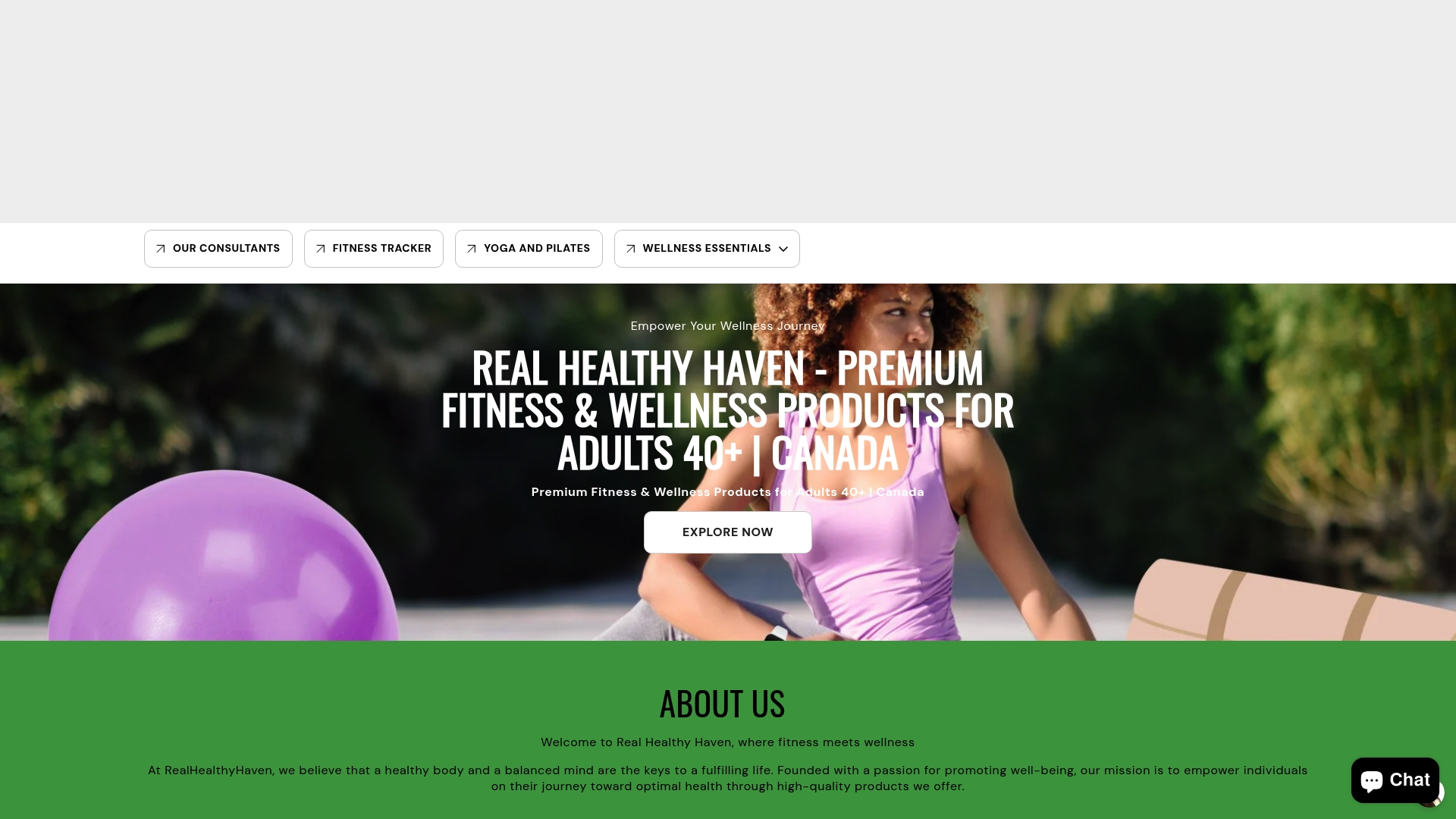
Explore a curated selection of proven fitness and wellness essentials designed just for Canadian adults 40 and up at Real Healthy Haven. From comfortable gym clothes that make movement easier, to reliable health monitors for tracking your progress, you will find what you need to follow every step outlined in your personal action plan. Start shopping now for expert-chosen equipment and special deals that help you make your healthy aging vision a reality. Take control today and give your goals the trusted support they deserve.
Frequently Asked Questions
How do I assess my current fitness level if I’m over 40?
To assess your current fitness level, start with a comprehensive evaluation that includes measuring your cardiovascular endurance, muscular strength, and flexibility. Schedule a physical examination with your healthcare provider and document your baseline measurements in a fitness journal to track progress.
What specific fitness goals should I set for healthy aging?
Focus on setting specific, measurable, attainable, relevant, and time-bound (SMART) goals. For instance, aim to walk continuously for 30 minutes within three months or perform 10 modified push-ups within six weeks.
How can I create a sustainable fitness action plan after 40?
To create a sustainable fitness action plan, break your goals into daily and weekly tasks that fit your lifestyle. For example, schedule three strength training sessions and two cardiovascular workouts each week to build consistency and support gradual progress.
What types of exercises should I incorporate into my routine for fitness after 40?
Incorporate low-impact cardiovascular activities, functional strength training, flexibility exercises, and balance work. Aim for at least 150 minutes of moderate exercise per week, such as brisk walking or yoga, to maintain overall health.
How often should I monitor my fitness progress?
Monitor your fitness progress every 4-6 weeks to assess improvements and adjust goals as needed. This might include checking your endurance, strength, or flexibility levels and noting any changes in how you feel overall.
What should I do if I hit a plateau in my fitness journey?
If you hit a plateau, consider adjusting your exercise routine by increasing intensity or trying new activities. For example, if you’ve been walking, switch to jogging for some sessions or incorporate new strength training exercises to keep challenging your body.
